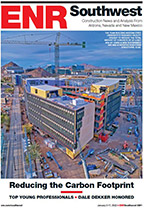Patrick MacLeamy, CEO of architect-engineer HOK, adds, "Steve is always in the forefront, looking for federal funding and private-sector support for the right way forward."
Selkowitz has long had his work cut out for him. Total U.S. building energy consumption was 50% higher in 2009 than it was in 1980, according to DOE data. In 2012, buildings alone accounted for 40% of energy consumption, including 73% of all electricity used and 2 billion metric tons, or 38%, of energy- related carbon dioxide emissions. Building owners spend $400 billion annually on energy.
Windows are a big part of that energy bill. In the 1980s, "we calculated that the annual loss of energy through American windows was about the same as the energy equivalent of the annual output of the oil field in Prudhoe Bay, Alaska," says physicist Arthur Rosenfeld, the Berkeley lab's distinguished scientist emeritus, cofounder of its 40-year-old environmental energy technologies program and Selkowitz's mentor.
Selkowitz says Rosenfeld's numbers have not changed. Though building products and systems are more energy-efficient, there are many more buildings.
DOE's goal is to help reduce energy use by 50% by 2030. "In FLEXLAB, DOE and industry partners can work side by side to explore major roadblocks to advancing integrated building systems and to deploy new technologies," says David Danielson, DOE assistant secretary for the Office of Energy Efficiency and Renewable Energy. EERE funded FLEXLAB under the American Recovery and Reinvestment Act of 2009.
FLEXLAB contains four two-cell test beds, each with its own mechanical system. Each reconfigurable test bed is designed as a mini office building, with interchangeable parts for experiments. One test bed even rotates 270˚, which enables direct comparison of identical strategies facing different directions. Another test bed will allow the study of net-zero-energy-use buildings. All studies can be done with or without occupants and with or without factoring in electric plug loads, considered the wild card in building energy use.
"Nothing like FLEXLAB exists anywhere in the world today," says Roland Risser, EERE director of building technologies.
Kent Peterson, chief engineer for P2S Engineering Inc., says, "FLEXLAB will provide a critically needed environment to test whole-building systems integration as we strive to produce significant energy reductions for net-zero energy-ready buildings."
Youthful Tinkerer
Born on March 8, 1948, Selkowitz says he spent many hours of his happy youth, in Boston's suburb of Newton, tinkering in the workshop of his late father, Israel, who was a pharmacist. "I liked to take things apart and try to put them back together," says Selkowitz.












Post a comment to this article
Report Abusive Comment